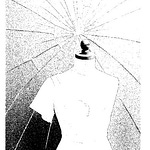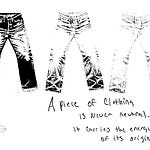Ah yes, another day, another think-piece clutching its pearls over the existential threat of “white men in fashion.” Apparently, every time a Belgian gets a creative director role, a social justice angel loses its wings. The narrative? Predictable. The outrage? Recycled. The nuance? Dead on arrival.
We’re told there's a shadowy cabal, let’s call it the Beige Illuminati™, meeting in silk-lined bunkers to ensure that no Black, brown, or non-male visionary ever touches a runway unless it’s as a diversity prop in someone else’s mood-board. Because clearly, LVMH and Kering are less concerned with revenue and brand equity and more devoted to maintaining the Pantone purity of their power structure. Makes perfect sense.
Except… it doesn’t.
What if, stay with me here, fashion’s not a white supremacist conspiracy, but just a ruthless, risk-averse, revenue-chasing machine run by people who care more about market share in Shanghai than your Twitter thread?
What if the real oppression isn’t who’s hired… but the fact that every act of criticism has been reduced to lazy templates and outrage algorithms designed not to reveal the truth, but to farm engagement?
In this episode, we’re not just poking holes in that fantasy, we’re torching it. Because when your rebellion is sponsored by retweets, and your activism fits neatly inside a carousel post, maybe, just maybe, you’re not decolonizing fashion. You’re just performing.
Let’s begin.
Let’s euthanize a tired little narrative, shall we?
There’s a growing cottage industry of performative outrage built on the idea that every Creative Director role in fashion is part of some white supremacist chessboard, where a cabal of pale male puppet-masters pull the strings in smoky boardrooms while stroking their Tom Ford lapels and whispering “keep it Aryan.” The reality? Far less cinematic. Far more boring.
The typical executive at a luxury conglomerate wouldn’t know ideological purity if it slapped them across the face with a sustainably-sourced Balenciaga tote. These aren’t cultural architects, they’re glorified brand managers in Prada sneakers. They don’t care about your politics. They care about price-per-square-foot retail yield. You could be a three-eyed, gender-fluid salamander fluent in Gen Z slang, if your collection converts at checkout, they’ll hand you the reins and a runway slot by Monday.
These aren’t shadowy patriarchs clutching pearls over the purity of the European lineage. They’re caffeine-addled spreadsheet jockeys monitoring KPIs and praying TikTok doesn’t cancel their brand by Q3. They don’t quote bell hooks. They quote net margin. They’re not reading Foucault. They’re sitting in glass offices, panic-refreshing Salesforce dashboards. Their cultural awareness begins and ends with, “Will this sell in Shanghai?”
And yet, the internet insists on painting them as the final bosses of some aesthetic apartheid, high priests of a secret white male order. As if “white man” is a coherent category. Since when did we decide that an Italian raised on Fellini and Catholicism, a Georgian shaped by post-Soviet trauma, a Belgian nurtured in postmodern surrealism, and a Frenchman obsessed with archival tailoring are all just the same cardboard cutout labeled: oppressor?
Apparently, we’ve traded centuries of cultural heritage for a Pantone chip. Nuance? Canceled. Context? Archived. Now all it takes is a vaguely European surname and a pale complexion to get stuffed into the catch-all filing cabinet labeled: Systemic Oppressor™.
We’ve collapsed entire civilizations, Italian, Georgian, Belgian, French, into a single shade of politically convenient beige. Never mind their wildly different histories, traumas, ideologies, or aesthetics. It’s all been flattened into one reductive narrative blob, airbrushed for maximum click-ability. This isn’t analysis, it’s astrology for activists. A race-flavored pseudoscience where struggle, soul, and stylistic genius are rendered irrelevant the second you don’t fit the outrage algorithm.
And here’s the actual atrocity, the casual erasure of brilliance masquerading as critique.
Demna’s existential chaos theory, delivered in couture drag? Glenn Martens’ brutalist alchemy that turned truck stop denim into sculptural art? Matthieu Blazy’s quiet resurrection of Bottega’s soul through movement and material?
You don’t have to like them, but reducing these men to beige stand-ins for privilege is like calling Miles Davis just “a guy who plays the trumpet.” It’s not just lazy. It’s anti-intellectual. It’s the ideological equivalent of throwing a Molotov cocktail at a library and calling it activism.
These aren’t placeholders. These are visionaries. Survivors of an industry that eats its young, poisons the idealistic, and demands blood for relevance. They didn’t get here by accident. They got here because their minds are rare, and their taste is lethal.
But of course, talent doesn’t trend. Outrage does.
Outrage is the new black. It goes with everything. It gets shared, screenshotted, stitched, and sanctified. It makes you look righteous without ever requiring you to read, research, or risk being wrong.
And so we end up in the kangaroo court of TikTok morality, where design genius is guilty until proven “inclusive,” and the aesthetic becomes secondary to the optics. Truth gets filtered through engagement metrics. And suddenly, the most interesting minds in fashion are collateral damage in a performative war no one’s actually trying to win, just milk.
Because when your critique is built for virality, not truth, there’s no room left for contradiction. No capacity for complexity. No recognition of excellence.
Just vibes. Just enemies. Just a rotating meat grinder of targets, ready for the next round of disposable discourse.
The real tragedy isn’t just the laziness, it’s the squandered chance to say something useful. Something dangerous. Something true.
Yes, the fashion system is broken, no one’s arguing that. It eats youth. It rewards sameness. It parades innovation while funding inertia. It fetishizes “emerging talent” in press releases and then quietly buries them in production minimums and unpaid press pulls.
But instead of dissecting the real disease, the financial sterility of bloated conglomerates, the extinction of mid-tier experimental labels, the way algorithmic sameness has turned taste into trend-churn, we get Instagram slideshows dressed in moral drag. Buzzfeed outrage in Bottega fonts. Thoughtless takedowns wrapped in the illusion of cultural insight.
Instead of asking why new voices can’t break through, we get digital witch trials accusing every creative director with a Y chromosome and an EU passport of gatekeeping the global fashion dream. As if Alessandro Michele is secretly running a white nationalist sleeper cell out of the Gucci archives. The truth? Far less cinematic. Far more depressing.
Fashion isn’t being killed by racism, it’s being killed by return on investment. Venture capital doesn’t fund vision. It funds predictable growth. And predictable growth means recycling the same three silhouettes, the same four faces, and the same five safe bets. Over and over. And over.
The real gatekeepers aren’t named Christophe or Karl. They’re called gross margin, sell-through rate, and social media velocity.
And guess what? They don’t care if you’re queer, BIPOC, neurodivergent, or descended from Balenciaga himself. They care if you can pump content on schedule and move units in South Korea. In this machine, “diversity” isn’t a value, it’s a line item on the brand strategy deck. A KPI dressed up in progressive language, just effective enough to be monetized and forgotten.
But confronting that? That would require thinking. And let’s be honest, nuance doesn’t get engagement.
Nuance doesn’t go viral. It doesn’t land you that TED Talk. It doesn’t earn you a brand ambassadorship for being just the right kind of angry. Nuance doesn’t make you the main character on Twitter. Because nuance asks you to look in the mirror.
Because here’s the punchline, it’s not just them keeping this broken system alive.
It’s you, too.
You, who double-tap posts about representation and then buy a hoodie from a mass-produced “activist” capsule made in the same factory as Shein. You, who repost DEI infographics while ghosting every emerging designer whose aesthetic isn’t already pre-approved by the trend cycle. You, who scream about gatekeeping and then worship resale exclusivity like it’s a sacrament.
You don’t want revolution. You want revolution with free shipping and Afterpay.
So no, you’re not toppling power. You’re not dismantling the system. You’re feeding it content.
You’re starring in a morality play where everyone claps, but nothing changes. You’re cosplaying resistance in last season’s moral panic. You’re farming clout in the name of critique, while the industry laughs, nods, and keeps printing money.
Because the system doesn’t fear your posts. It absorbs them.
Critique without complexity is just content. And congratulations, you’re now a brand asset.
So post your carousel. Drop your thread. Chant “representation” like a brand mantra while wearing limited-edition oppression made by underpaid garment workers.
The system isn’t scared. It’s monetizing your rebellion in real time.
You’re not the resistance. You’re the advertisement.
And let me be clear, I genuinely don’t care how this sounds. I’m not here to coddle fragile egos or bow to the aesthetic of false progress. At Counterstatement, the mission is simple: say what everyone feels but no one dares articulate. Put language to the quiet truths that rattle around this industry like ghosts no one wants to name.
And frankly? I think I’m the only one left with the guts to say anything that actually means something anymore.
I’m not chasing approval. I’m not interested in the group chat consensus. I’m not licking the boots of some fashion think tank built out of PR-approved buzzwords and empty calories.
I read the same magazines you do, Vogue, Dazed, i-D, GQ, 1Granary, and I swear to God, it’s like watching the entire industry undergo a collective lobotomy. No risk. No rigor. Just pixelated pastries of cultural content, airbrushed, algorithmic, and intellectually malnourished.
No protein. No teeth. Just sugar-coated cowardice dressed up in cool fonts.
What a f*cking shame.
Because fashion deserves better. And we will not design a new future by whispering safe platitudes into echo chambers built by corporate interns.
No, someone has to be willing to rip the curtain back. To point directly at what’s rotting beneath the surface. To offend, to dissect, to disturb.
That’s what Counterstatement is for. And if that makes people uncomfortable?
Good.
It’s supposed to.













